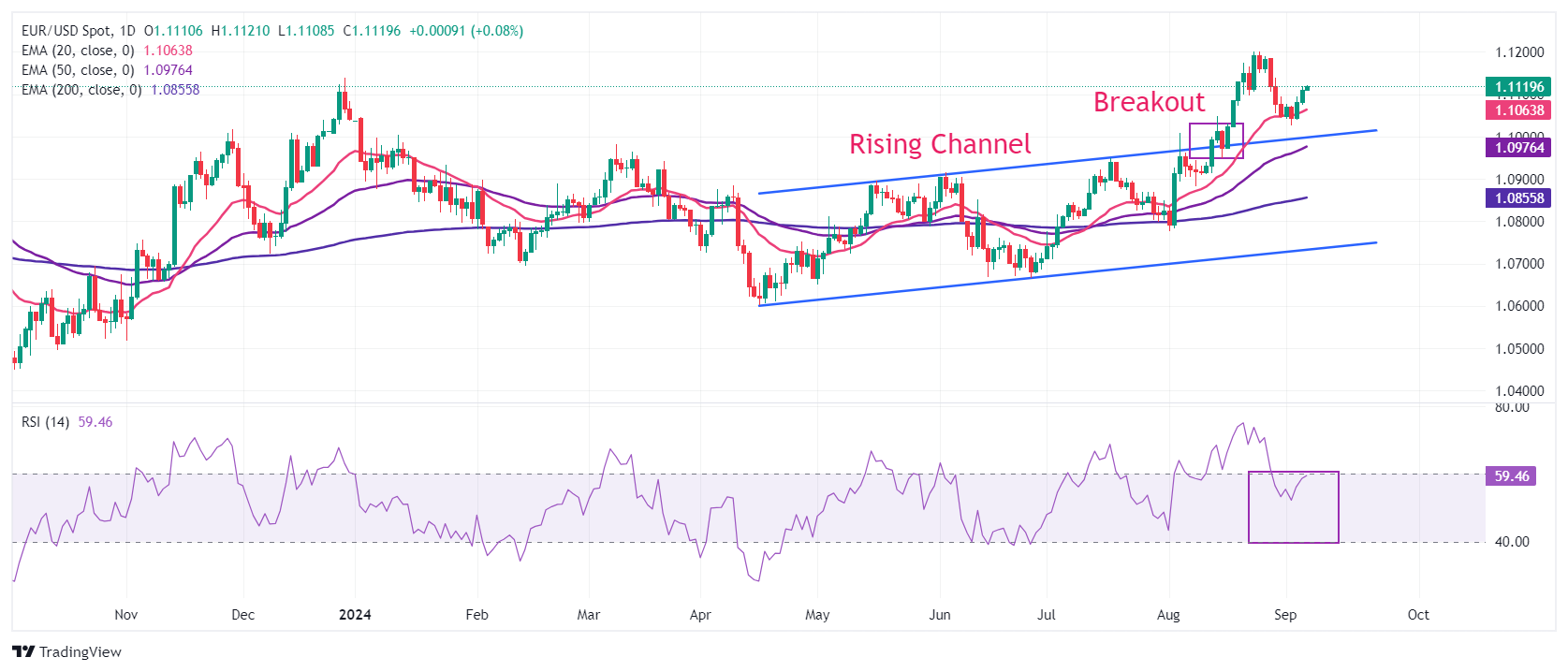EUR/USD stays above 1.1100 with US NFP on the horizon
- EUR/USD extends its upside above 1.1100 as signs of a slowdown in US labor demand weigh on the US Dollar.
- Investors await the US NFP for August as markets wonder if July’s report was just a bump or the start of a more serious deterioration.
- The ECB is expected to cut interest rates two more times this year.
EUR/USD extends its winning spree for the third consecutive trading session on Friday, trading close to a fresh weekly high of 1.1120. Decent gains in the shared currency pair are driven by sheer weakness in the US Dollar (USD). The US Dollar Index (DXY), which tracks the Greenback’s value against six major currencies, slides further below the crucial support of 101.00.
The appeal for the US Dollar has weakened after United States (US) JOLTS Job Openings data for July and the ADP Employment data for August, released earlier this week, deepened fears of deteriorating labor market conditions. Fresh job vacancies and additions of payrolls in the private sector stood at 7.67 million and 99K, respectively, the lowest in more than three-and-a-half years.
The US ISM Services Purchasing Managers’ Index (PMI) data for August came in better than projected but failed to cushion the US Dollar.
Signs of slowing labor demand prompted market expectations that the Federal Reserve (Fed) could start cutting interest rates aggressively. According to the CME FedWatch tool, the possibility for the Fed to begin reducing interest rates by 50 basis points (bps) to 4.75%-5.00% has increased to 41% from 34% recorded a week ago.
For more cues on the interest rate path, investors will focus on the US Nonfarm Payrolls (NFP) data for August, which will be published at 12:30 GMT. The official employment data is expected to show that US employers hired 160K job-seekers, higher than July’s reading of 114K. The Unemployment Rate is estimated to have declined to 4.2% from the former release of 4.3%.
Investors will also focus on the US Average Hourly Earnings data, a key measure of wage growth that influences consumer spending. Earnings are expected to have accelerated to 3.7% from 3.6% in July on a year-on-year basis. The wage growth measure is seen growing by 0.3% on the month, faster than the prior increase of 0.2%.
Daily digest market movers: EUR/USD rises as US Dollar weakens
- EUR/USD rises on sheer weakness in the US Dollar ahead of the US NFP data. By itself, the Euro (ECB) exhibits a mixed performance against its major peers as traders aren’t sure about the European Central Bank (ECB) interest rate path for the remainder of the year.
- The ECB is widely anticipated to cut interest rates again in the September meeting. The central bank started the policy-easing process in June but kept its key borrowing rates unchanged in July. For the last quarter of this year, traders remain split on whether the ECB will cut in the November or December meeting, or in both of them.
- Economists at Bank of America (BofA) said in their latest viewpoint on the Eurozone: "We still see more cuts in 2025/26 than the markets are pricing, with a return to a deposit rate of 2% by 3Q25 (at the latest) and to 1.5% in 2026." BofA analysts said that the recovery in the Eurozone remains fragile and will likely be shallow, pressured by several economic factors including slowing growth in China as well as political factors.
- Further evidence of economic struggle came from the Eurozone’s two largest economies. Industrial production in Germany fell 2.4% on month in July, much more than the 0.3% decline expected by economists. In France, Industrial Output fell by 0.5%.
- According to a Reuters poll carried out between August 30 and September 5, 85% of economists anticipate that the ECB will cut interest rates next week and again in the December meeting.
- Meanwhile, most ECB officials seem to be comfortable with market speculation for interest rate cuts as they remain worried about growing risks to Eurozone economic growth. ECB Executive Board member Piero Cipollone said in an interview with a French newspaper this week that "there is a real risk that [the ECB] stance could become too restrictive."
Technical Analysis: EUR/USD holds gains above 1.1100

EUR/USD remains steady above the round-level figure of 1.1100. The near-term outlook of the major currency pair remains firm as it manages to gain firm footing near the 20-day Exponential Moving Average (EMA) around 1.1055.
The longer-term outlook is also bullish as the 50-day and 200-day EMAs at 1.0970 and 1.0865, respectively, are sloping higher. Also, the shared currency pair holds the Rising Channel breakout on a daily time frame.
The 14-day Relative Strength Index (RSI) has declined below 60.00 after turning overbought near 75.00.
On the upside, the recent high of 1.1200 and the July 2023 high at 1.1275 will be the next stop for the Euro bulls. Meanwhile, the downside is expected to remain cushioned near the psychological support of 1.1000.
Euro FAQs
The Euro is the currency for the 20 European Union countries that belong to the Eurozone. It is the second most heavily traded currency in the world behind the US Dollar. In 2022, it accounted for 31% of all foreign exchange transactions, with an average daily turnover of over $2.2 trillion a day. EUR/USD is the most heavily traded currency pair in the world, accounting for an estimated 30% off all transactions, followed by EUR/JPY (4%), EUR/GBP (3%) and EUR/AUD (2%).
The European Central Bank (ECB) in Frankfurt, Germany, is the reserve bank for the Eurozone. The ECB sets interest rates and manages monetary policy. The ECB’s primary mandate is to maintain price stability, which means either controlling inflation or stimulating growth. Its primary tool is the raising or lowering of interest rates. Relatively high interest rates – or the expectation of higher rates – will usually benefit the Euro and vice versa. The ECB Governing Council makes monetary policy decisions at meetings held eight times a year. Decisions are made by heads of the Eurozone national banks and six permanent members, including the President of the ECB, Christine Lagarde.
Eurozone inflation data, measured by the Harmonized Index of Consumer Prices (HICP), is an important econometric for the Euro. If inflation rises more than expected, especially if above the ECB’s 2% target, it obliges the ECB to raise interest rates to bring it back under control. Relatively high interest rates compared to its counterparts will usually benefit the Euro, as it makes the region more attractive as a place for global investors to park their money.
Data releases gauge the health of the economy and can impact on the Euro. Indicators such as GDP, Manufacturing and Services PMIs, employment, and consumer sentiment surveys can all influence the direction of the single currency. A strong economy is good for the Euro. Not only does it attract more foreign investment but it may encourage the ECB to put up interest rates, which will directly strengthen the Euro. Otherwise, if economic data is weak, the Euro is likely to fall. Economic data for the four largest economies in the euro area (Germany, France, Italy and Spain) are especially significant, as they account for 75% of the Eurozone’s economy.
Another significant data release for the Euro is the Trade Balance. This indicator measures the difference between what a country earns from its exports and what it spends on imports over a given period. If a country produces highly sought after exports then its currency will gain in value purely from the extra demand created from foreign buyers seeking to purchase these goods. Therefore, a positive net Trade Balance strengthens a currency and vice versa for a negative balance.

